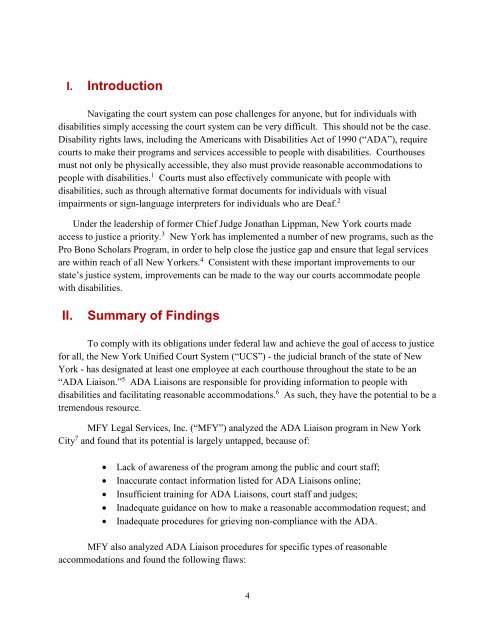Barriers to Justice
kAst305MjV6
kAst305MjV6
Create successful ePaper yourself
Turn your PDF publications into a flip-book with our unique Google optimized e-Paper software.
I. Introduction<br />
Navigating the court system can pose challenges for anyone, but for individuals with<br />
disabilities simply accessing the court system can be very difficult. This should not be the case.<br />
Disability rights laws, including the Americans with Disabilities Act of 1990 (“ADA”), require<br />
courts <strong>to</strong> make their programs and services accessible <strong>to</strong> people with disabilities. Courthouses<br />
must not only be physically accessible, they also must provide reasonable accommodations <strong>to</strong><br />
people with disabilities. 1 Courts must also effectively communicate with people with<br />
disabilities, such as through alternative format documents for individuals with visual<br />
impairments or sign-language interpreters for individuals who are Deaf. 2<br />
Under the leadership of former Chief Judge Jonathan Lippman, New York courts made<br />
access <strong>to</strong> justice a priority. 3 New York has implemented a number of new programs, such as the<br />
Pro Bono Scholars Program, in order <strong>to</strong> help close the justice gap and ensure that legal services<br />
are within reach of all New Yorkers. 4 Consistent with these important improvements <strong>to</strong> our<br />
state’s justice system, improvements can be made <strong>to</strong> the way our courts accommodate people<br />
with disabilities.<br />
II.<br />
Summary of Findings<br />
To comply with its obligations under federal law and achieve the goal of access <strong>to</strong> justice<br />
for all, the New York Unified Court System (“UCS”) - the judicial branch of the state of New<br />
York - has designated at least one employee at each courthouse throughout the state <strong>to</strong> be an<br />
“ADA Liaison.” 5 ADA Liaisons are responsible for providing information <strong>to</strong> people with<br />
disabilities and facilitating reasonable accommodations. 6 As such, they have the potential <strong>to</strong> be a<br />
tremendous resource.<br />
MFY Legal Services, Inc. (“MFY”) analyzed the ADA Liaison program in New York<br />
City 7 and found that its potential is largely untapped, because of:<br />
<br />
<br />
<br />
<br />
<br />
Lack of awareness of the program among the public and court staff;<br />
Inaccurate contact information listed for ADA Liaisons online;<br />
Insufficient training for ADA Liaisons, court staff and judges;<br />
Inadequate guidance on how <strong>to</strong> make a reasonable accommodation request; and<br />
Inadequate procedures for grieving non-compliance with the ADA.<br />
MFY also analyzed ADA Liaison procedures for specific types of reasonable<br />
accommodations and found the following flaws:<br />
4


